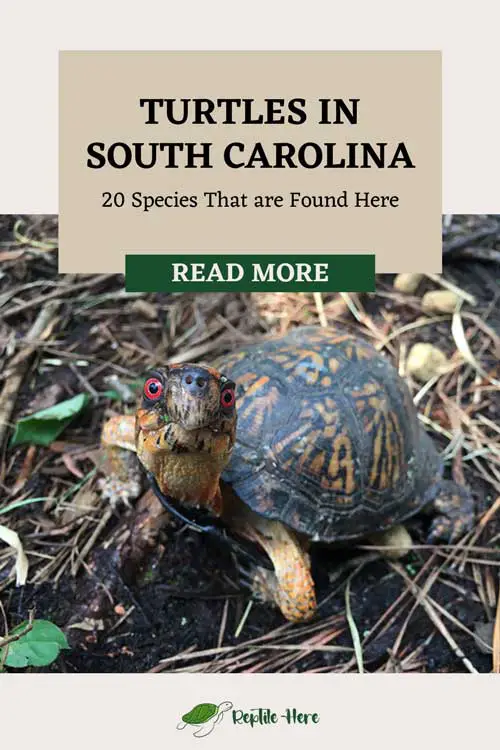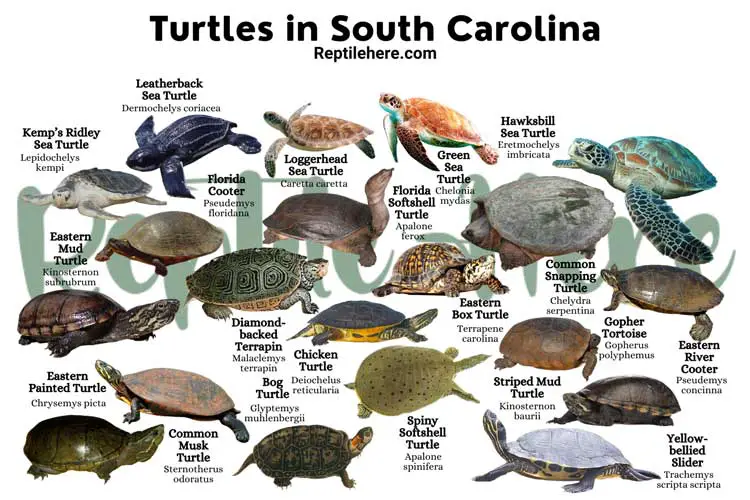Turtles in South Carolina – 20 Species That are Found Here
South Carolina is home to 20 species of turtles. 14 of these turtles are native to the state and include the snapping turtles, softshells, chicken turtles, painted turtles, diamondback terrapins, Cooter turtles, mud turtles, musk turtles, and more.
Moreover, the state is home to one endangered species of tortoises—the gopher tortoise!
On top of all this, South Carolina hosts the endangered 5 sea turtle species ranging from the green sea turtles to the leatherback turtles, and loggerhead sea turtles.
The following list features all the 20 species of turtles in South Carolina. For every species, we have shared key facts such as average adult size, physical appearance, habitat, diet, average lifespan, and more.
20 Types Of Turtles in South Carolina
Contents
1. Common Snapping Turtle
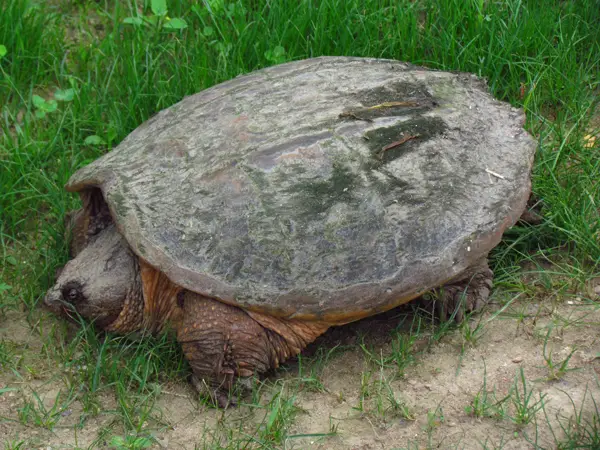
- Scientific name: Chelydra serpentina
- Common name: Snapping Turtle
- Family: Chelydridae
- Size: 8 to 18 1/2 inches
- Lifespan: 30 to 50 years or more
- Conservation status: Least Concern
Common snapping turtles are widespread throughout South Carolina. An average adult is pretty large and has a shell length of 18½ inches long.
This species has a chunky head, a long tail, and large webbed feet. The shell color is black or olive and has no distinct pattern. These South Carolina snapping turtles are known for their powerful jaws—they’re so strong that these turtles eat other turtles!
You’ll find them in waterbodies with muddy bottoms. Examples include marshes, ponds, lakes, rivers, and even shallow streams. They generally prefer waters with aquatic vegetation in plenty and foods such as fish, frogs, birds, etc.
These South Carolina turtles generally show docile behavior but can get quite aggressive if taken out of water. The best way to calm it is to take it back to the waters, where it feels safe.
2. Eastern Painted Turtle
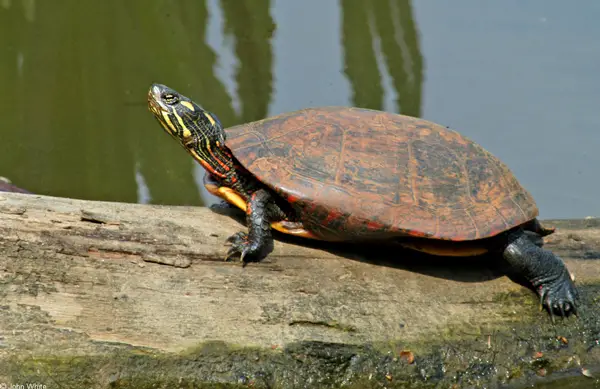
- Scientific name: Chrysemys picta picta
- Common name: Painted Turtle
- Family: Emydidae
- Size: 4 to 6 inches
- Lifespan: 30 to 50 years
- Conservation status: Least Concern
The Eastern painted turtle is one of the most recognizable turtle species in South Carolina, thanks to its beautiful and unique coloring.
The bright reds and yellow-green markings on its shell, head, and limbs are no doubt a beauty to behold!
This painted turtle sub-species in South Carolina has been observed to live near water bodies with minimal movements. Examples include marshes, ponds, slow-moving streams with sandy/muddy bottoms, small lakes, etc.
They also prefer areas with aquatic plants in plenty as they make their primary food source in the wild.
One interesting fact about these South Carolina turtles is their ability to hold their breath for up to 30 hours when inside temperate water. Moreover, they’re capable of standing dominant in freezing cold waters for up to 4 months.
Unfortunately, it’s not easy to establish the population of these turtles in South Carolina. This is because most people who pet them end up releasing them back into the wild.
This contributes to an ever-expanding range plus unstable reproduction rates for these turtles.
3. Florida Softshell Turtle
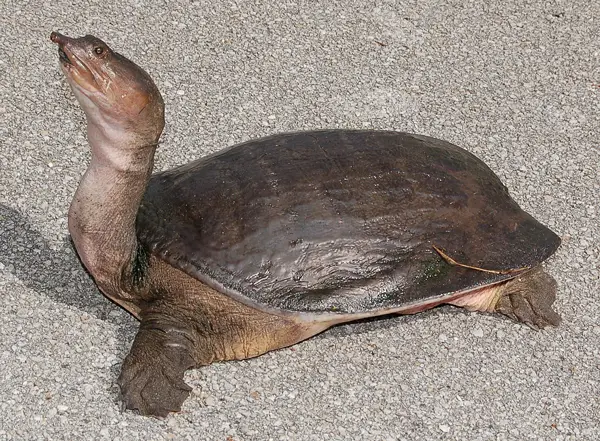
- Scientific name: Apalone ferox
- Common name: Florida Softshell Turtle, Softshell Turtle
- Family: Trionychidae
- Size: 11 to 24 inches (females), 6 to 12 inches (males)
- Lifespan: 50+ years
- Conservation status: Least Concern
Florida softshell turtle is the largest softshell species residing in Northern America! It is also the ONLY softshell native to regions of North Carolina, South Carolina, and Florida.
This softshell species is marked by a dark brown to olive green upper shell with a leathery texture and pancake appearance. The plastron is usually white or gray.
Florida softshells are mainly carnivorous and will feed on insects, worms, mollusks, and fish strips.
The turtle is almost fully aquatic and prefers residing in shallow and muddy water bodies like slow-moving streams and ponds. Its thin snout enables it to breathe while still being submerged in the water as it hides from predators or hunts for food.
Note that this Florida softshell turtle in South Carolina is fast both on land and in the waters!
They don’t like being handled and will often try resisting by biting or scratching with their teeth or sharp claws. They can also be kept as a pet turtles, and are ideal for more advanced pet owners.
4. Spiny Softshell Turtle
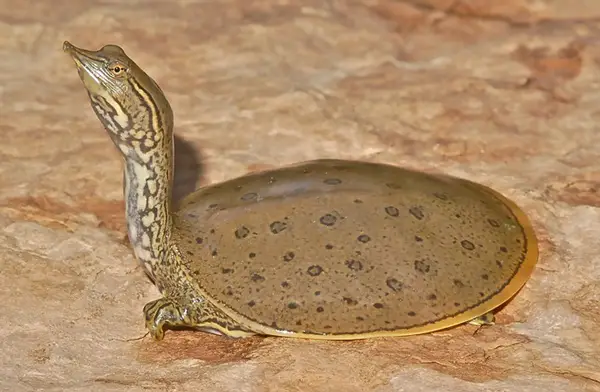
- Scientific name: Apalone spinifera
- Common name: Spiny Softshell Turtle
- Family: Trionychidae
- Size: 5 to 9 inches (males), 12 to 20 inches (females)
- Lifespan: 30 to 70 years
- Conservation status: Least Concern
The Spiny softshell turtle is a medium-to-large freshwater species that lives in South Carolina’s lakes, streams, and rivers with muddy or sandy bottoms and little or no vegetation.
Female spiny softshell turtles are usually larger than males. And unlike other turtles, this species has a flexible, leather-like carapace that’s extremely rounded and flattened. The shell color can be olive grey or yellow-brown. Just like other softshell turtles, this species also has a snorkel-like snout.
The young ones feature well-defined round spots that are easily visible on the shell (though these spots become invisible as they transition to adulthood).
Spiny softshell turtles in South Carolina tend to eat anything they find in the waters including crayfish, insects, small fish, and so on. They hunt by burying themselves in the mud or sand while keeping their head uncovered to grab food as it swims by.
These turtles are also able to breathe underwater by taking in oxygen through their throat skin. This is a useful adaptation given that they don’t spend a lot of time out of water.
Other adaptations of these turtles include webbed feed, long claws, and extremely flat shells that enable them to quickly swim away from predators and burry in the muddy bottom of the waters they reside in.
5. Chicken Turtle
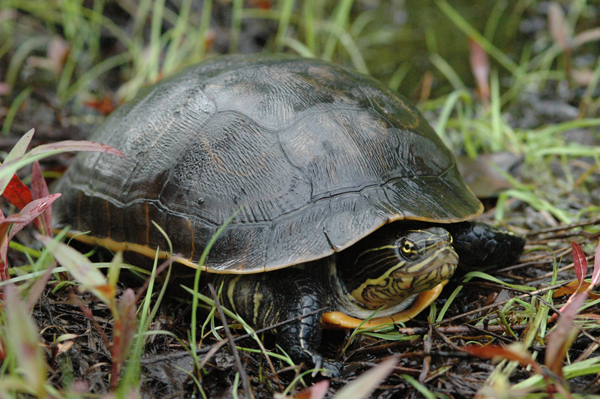
- Scientific name: Deiochelus reticularia
- Common name: Chicken Turtle
- Family: Emydidae
- Size: 4 to 6 inches
- Lifespan: 15 to 30 years
- Conservation status: Least Concern
The chicken turtle is, without a doubt, the most social turtle species you’ll find in South Carolina! They’re known to bask or swim in groups and rarely live or travel alone.
The easiest way to observe them is when they’re basking, since most of their activities, including reproduction and feeding, happen underwater.
Chicken turtle shells are egg-shaped compared to other turtles and are black or dark brown in color. They also feature subtle yellow patterns. The lower side of the shell is usually yellow and the skin is dark and covered with yellow stripes.
Chicken turtles of South Carolina prefer living in still water areas such as ponds, marshes, and ditches in South Carolina. However, it is also easy to spot them on land when they’re foraging for food or basking in the sun.
For the diet part, chicken turtles are omnivorous and like eating meat, fish, snails, insects, aquatic vegetation, and land plant matter such as fruits and veggies.
An interesting fact: Chicken turtles are so named because of their meat taste, which was a popular delicacy back in the 1970s!
6. Eastern River Cooter
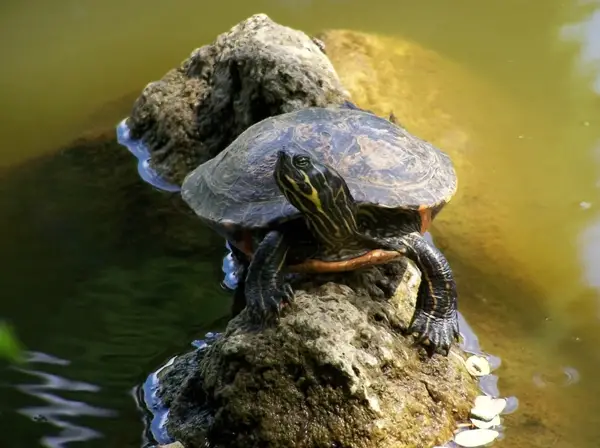
- Scientific name: Pseudemys concinna
- Common name: River Cooter
- Family: Emydidae
- Size: 8 to 12 inches
- Lifespan: 20 to 40 years
- Conservation status: Least Concern
River Cooter turtles are also inhabitants of the eastern half region of South Carolina. They’re known to be solitary creatures and often like basking alone in the sun. However, they can be sometimes observed sharing habitat with painted turtles and red-eared sliders.
They’re distinguishable by their brown to olive or dark-green outer shell and lighter c-shaped, concentric markings in their scutes. Their skin can be olive or olive-brown in color, with numerous yellow lines.
Most of these turtle adults are around 8 to 12 inches in size, though it’s not rare to come across females with a bigger size—up to 15 inches.
These turtles are pretty fast both on land and in water. They’re found in various freshwater bodies including lakes, ponds, and rivers in South Carolina. They’re also found in brackish water.
Their diet is primarily herbivorous and mainly consists of various forms of aquatic vegetation and land plant matter, including fruits and vegetables. They’re however known to occasionally feed on insects and snails.
7. Florida Cooter
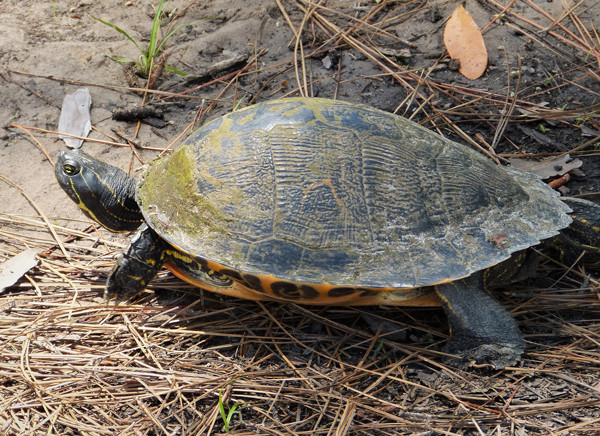
- Scientific name: Pseudemys floridana
- Common name: Coastal Plain Cooter, Florida Cooter
- Family: Emydidae
- Size: 8 to 12 inches
- Lifespan: 20 to 40 years
- Conservation status: Least Concern
Florida Cooter is another pond turtle found within the borders of South Carolina. It is one of the largest Cooter turtle species in the state and is mainly found across the state’s North Eastern half.
This turtle is recognized for its relatively flat shape compared to other Cooter turtles. It has a dark green shell with a swirling orange pattern. Though Florida Cooter may look similar to the eastern river Cooter above, it (Florida Cooter) lacks C-shaped markings on its carapace.
Also referred to as a coastal plain Cooter, this turtle is semi-aquatic and prefers living in coastal plains, swamps, or rivers with sandy bottoms in South Carolina.
Florida Cooters are sometimes observed basking in social groups on logs above the waters.
It is primarily herbivorous but will also eat insects if they’re in abundance and easy to catch.
Unfortunately, the population of this Cooter is on the decline in South Carolina. This is due to excessive hunting for pet trade or for meat (human consumption).
8. Diamond-backed Terrapin
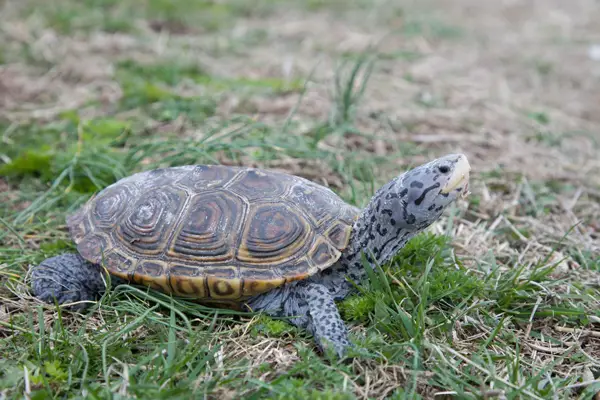
- Scientific name: Malaclemys terrapin
- Common name: Diamondback Terrapin, Mississippi Diamondback Terrapin
- Family: Emydidae
- Size: 4 to 6 inches (males), 5 to 8 inches (females)
- Lifespan: 25 to 35 years
- Conservation status: Vulnerable
The diamondback terrapin is the only freshwater species in South Carolina that can adapt to saltwater as well. Their shells have a raised diamond shape, hence the name diamondback. The term “terrapin” simply means little turtle.
A typical diamondback terrapin in South Carolina has black or brown carapace and yellow lower shell that may sometimes feature dark-colored patterns. The turtle’s skin is usually grey-white with multiple small black spots.
Female diamondback terrapins are usually bigger than their male counterparts.
These turtles are highly timid and can easily get stressed when in captivity. They’re pretty docile and can be handled. However, they’re known to bite as a way of defending themselves if they feel threatened.
Diamondback terrapins can be found along the coast in tidal flats, salt marshes, barrier beaches, and brackish streams in South Carolina. They can also stay in full-strength saltwater for longer periods of time.
The terrapins are largely carnivorous and feed on crustaceans, fish, crabs, shrimps, marine snails, marine worms, mollusks, mussels, clams, and barnacles. However, they also tend to occasionally ingest small amounts of plant matter.
9. Eastern Mud Turtle
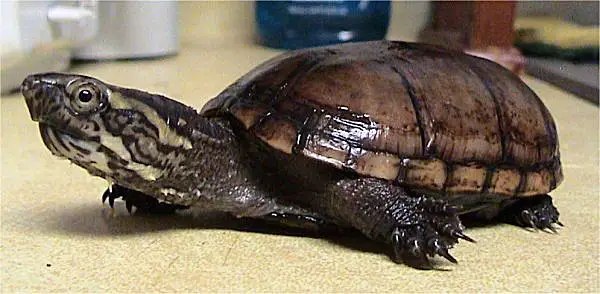
- Scientific name: Kinosternon subrubrum
- Common name: Eastern Mud Turtle, Mud Turtle
- Family: Kinosternidae
- Size: 3 to 5 inches
- Lifespan: 50 years
- Conservation status: Least Concern
The Eastern Mud turtle in South Carolina is found in shallow waters including ditches, marshes, wet meadows, and swamps.
This smaller aquatic turtle species is characterized by a smooth and unmarked shell. Yes, it has an incredible plain look, with its upper shell lacking any patterns. The carapace color ranges from dark yellow to black.
The lower side of the shell is also pretty plain, though it usually appears lighter on the upper part. The key distinction of this mud turtle is the stripes on its head which can be white or yellow in color.
One particular feature that sets this turtle apart from others and makes it easily identifiable is the hinges on its lower shell which form a “K” shape when viewed from the sides.
Just as its name suggests, this turtle lives in water bodies with a soft muddy, or sandy bottom. Thus, they can be found in marshes, swamps, and rivers in South Carolina.
Since the South Carolina eastern mud turtle is omnivorous, it eats meat, fish, snails, insects, and aquatic vegetation as well as plant matter on land.
Unlike other turtles, eastern mud turtles do not hibernate in the cold winter months. Instead, it does the opposite—it becomes dormant in the hot months of summer (this is known as aestivation).
Also read: Turtles In Idaho
10. Striped Mud Turtle
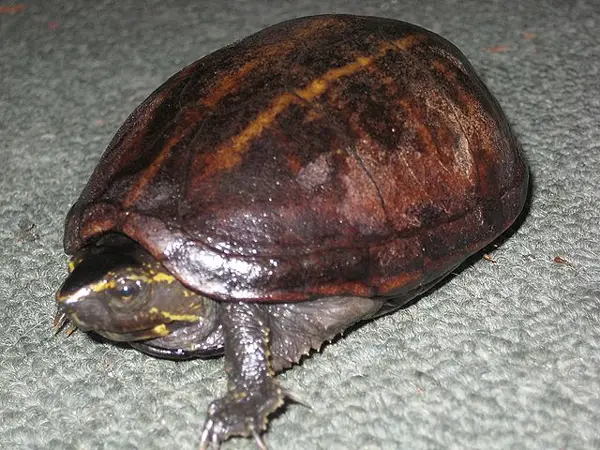
- Scientific name: Kinosternon baurii
- Common name: Striped Mud Turtle, Three-Striped Mud turtle
- Family: Kinosternidae
- Size: 4 to 5 inches
- Lifespan: 15 to 20 years
- Conservation status: Least Concern
The striped mud turtle has been spotted in the South Carolina state’s shallow and smaller waterbodies. You’ll most likely see them in the cypress swamps, ditches, and drainage canals in South Carolina.
Striped mud turtles usually have dark-brown oval-shaped shells, with 3 yellowish vertical stripes (hence their name).
The turtle species are quite easy to spot in South Carolina than other mud turtles as they spend more time on land than in water. They are unlike other mud turtles in that they sun themselves, forage for insects, and like resting out of the waters.
South Carolina striped mud turtle is omnivorous and eats snails, insects, fish, algae, carrion, and even plants. The turtle has also been observed eating dried krill.
Note that this turtle species of South Carolina is considered an imperiled species. Nonetheless, this small aquatic species is no longer considered under the status of Federal Endangered Status.
11. Common Musk Turtle
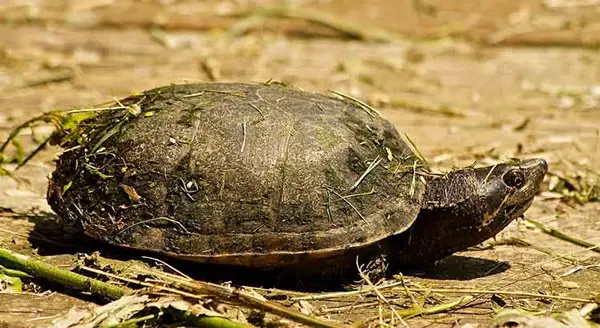
- Scientific name: Sternotherus odoratus
- Common name: Common Musk Turtle, Eastern Musk Turtle, Musk Turtle, Stinkpot
- Family: Kinosternidae
- Size: 2 to 4.5 inches
- Lifespan: 30 to 50 years
- Conservation status: Least Concern
The Common Musk Turtle is another aquatic turtle found in South Carolina’s slow-moving and sluggish streams as well as still water bodies. The turtle usually prefers areas with dark crevices, where it can easily hide. It also prefers lots of plant matter to burrow in and hide.
An average adult eastern musk turtle is quite small (2 to 4.5 inches long). It has a pretty plain appearance with highly consistent colors. Both the shell and skin usually share the same color and can range from dark brown to black.
The turtle shell has one unique feature—a ridge traversing its entire shell length. Besides, it has another distinctive feature: two light-colored stripes on its head.
Common musk turtles of South Carolina are herbivorous and will eat small aquatic or semi-aquatic animals, carrion, and aquatic vegetation. They will also feed on any other vegetation on land.
When it feels threatened, this turtle species emits a foul odor (a musky odor, hence its name). This scent can be detected in water or on land. It can also easily waft through the air to its predators.
Also, these South Carolina turtles are good at climbing trees! This great capability enables them to go high up tree branches to find a safe resting place and avoid predators.
12. Bog Turtle
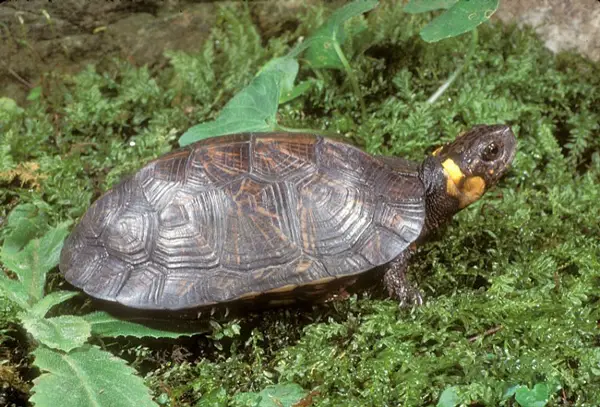
- Scientific name: Glyptemys muhlenbergii
- Common name: Bog Turtle, Muhlenberg’s turtle
- Family: Emydidae
- Size: 3.5 to 5 inches
- Lifespan: up to 40 years
- Conservation status: Critically Endangered
The Bog turtle is the smallest aquatic turtle you’ll find in South Carolina and North America in general.
The species is critically endangered and is one of the rarest turtles in the state; it is only seen in the western counties of South Carolina.
Mind you; selling or owning a bog turtle in South Carolina is illegal!
An adult bog turtle’s carapace coloration ranges from black to olive or dark brown and features a central keel ridge. Some of the scutes making up their upper shell may also bear red or yellow-star markings. And their heads have distinctive orange or yellow patches.
The bog turtle is known to inhabit wetland areas such as marshes or bogs populated with grass cover.
These turtle species are diurnal omnivores and like eating insects, mollusks, and occasional vegetation. They’re most active during warm parts of the day.
13. Yellow-bellied Slider
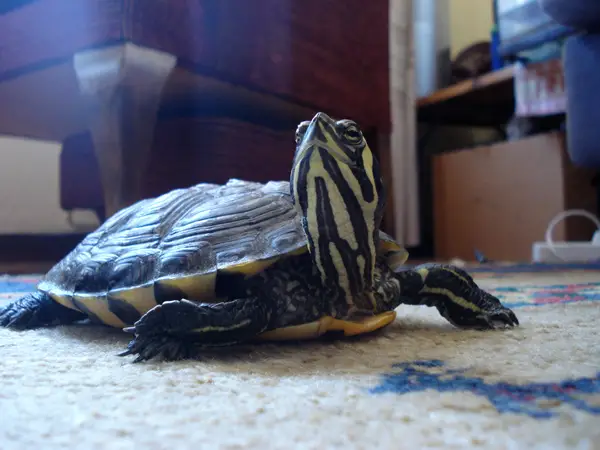
- Scientific name: Trachemys scripta scripta
- Common name: Yellow-bellied slider
- Family: Emydidae
- Size: 8 to 13 inches (females), 5 to 9 inches (males)
- Lifespan: 30 to 40 years
- Conservation status: Least Concern
The yellow-bellied slider turtle is a sub-species of pond sliders native to the Southern region of the United States, including South Carolina.
It is a semi-aquatic turtle that lives in water as well as land. And it can be found in a variety of habitats including floodplain swamps slow-moving rivers, seasonal wetlands, marshes, and even permanent ponds.
As the name suggests, this turtle features a yellowish plastron. Plus, it bears yellowish markings on its skin, not to forget prominent yellow stripes behind its eyes. The upper shell color ranges from dark brown to olive.
These South Carolina sliders are omnivorous and like eating fish, snails, insects, and aquatic vegetation. they also eat land vegetation, including fruits and vegetables.
It is also worth noting that South Carolina Yellow-bellied sliders are a popular choice of pet turtles for most folks. They don’t require a lot of special care, which makes them a favorite for many folks.
14. Green Sea Turtle
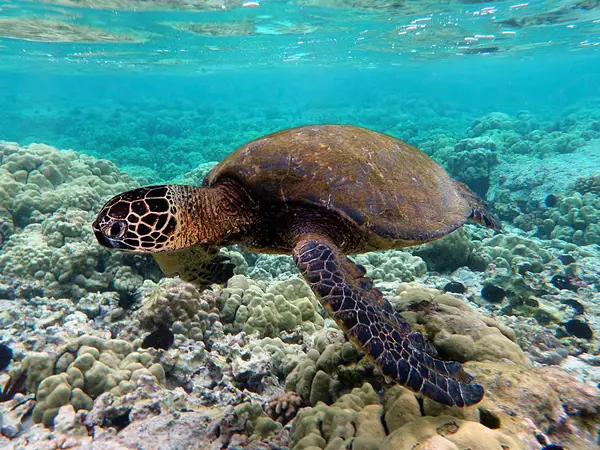
- Scientific name: Chelonia mydas
- Common name: Green turtle, Pacific green turtle, Black sea turtle
- Family: Cheloniidae
- Size: 2 to 5 feet
- Lifespan: 60 to 70 years
- Conservation status: Endangered
The green sea turtle species is classified among the largest hard-shelled sea turtles in South Carolina. It can reach up to 4 feet in length and weighs up to 400lbs.
This species is characterized by scutes that run down the middle; they’re 4 on each side. The shell color can be gray, dark brown, or olive with a yellow-to-white bottom shell or plastron.
It also features a serrated beak on its lower jaw and two large scales resign between the eyes.
Males are generally larger than females and have longer tails. The females lay their eggs on the beach and use their paddle-shaped flippers to easily burrow in the sand when laying eggs. A single green turtle can lay up to 200 eggs!
This South Carolina sea turtle species gets its name from its primary diet which consists of age and seagrasses (mind you, this diet is responsible for tinting its cartilage green).
Green turtles in South Carolina are usually found in tropical as well as subtropical waters throughout the years. They also tend to migrate to cooler temperatures and even boreal waters when the weather gets warmer.
15. Hawksbill Sea Turtle
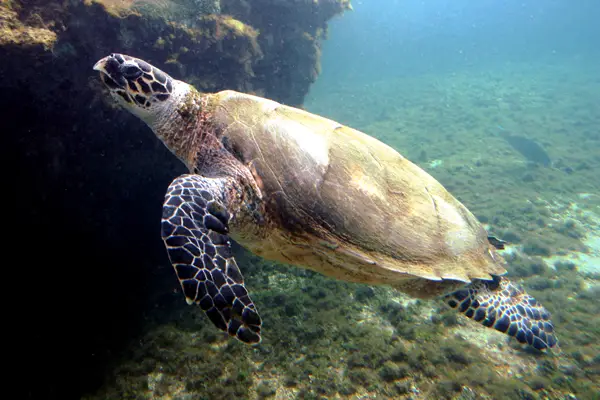
- Scientific name: Eretmochelys imbricata
- Common name: hawksbill turtle
- Family: Cheloniidae
- Size: 2.5 to 3 feet
- Lifespan: 50 to 60 years
- Conservation status: Critically endangered
Hawksbill sea turtles have been found in South Carolina’s shallow coastal areas or tropical, or rocky waters. It can also be spotted in the reefs and estuaries.
The adult has an average size of 3 feet and weighs around 180 pounds. The shell of this turtle has an amber carapace with irregular light and dark streaks. They also feature predominant black and molten-brown easily radiating to the sides.
The shell tends to change color depending on the water temperatures.
This colored and patterned shell makes this turtle highly valuable and is commonly sold as “tortoiseshell” in the markets.
The hawkbill turtle is so named due to its narrow, pointed beak. It also has a distinctive pattern of overlapping scales on its shells which form a serrated look on the edges.
These turtles mainly feed on the sponge which they easily extract from reef crevices with the help of their narrow, pointed beaks. They also feed on jellyfish.
Hawkbill turtles are generally found in tropical oceans throughout the world. While they live in the open ocean, they tend to spend more time in coral reefs and shallow lagoons in South Carolina.
During nesting, a female hawkbill turtle will look for small coves, “pocket” beaches, or inlets surrounded by rocks. They tend to travel high up the beach to lay eggs in shelters formed by the plants.
16. Kemp’s Ridley Sea Turtle
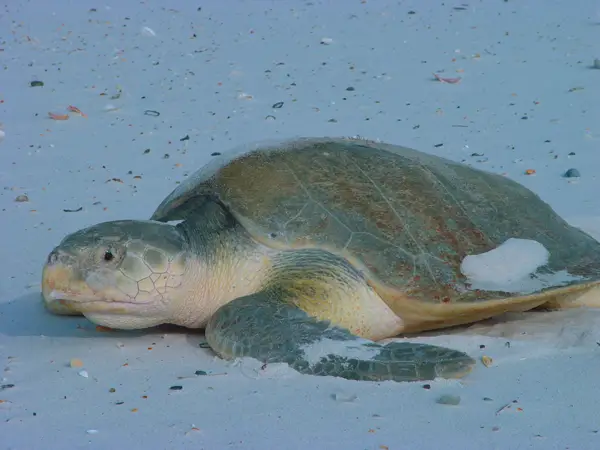
- Scientific name: Lepidochelys kempi
- Common name: Atlantic ridley sea turtle,
- Family: Cheloniidae
- Size: 2+ feet
- Lifespan: 30+ years
- Conservation status: Critically endangered
Kemp’s ridley sea turtle is the smallest species of all the sea turtles in South Carolina. The average adult size is about 2 feet and weighs approx. 110 lbs. They have adapted flippers (front limbs) and a beak.
This turtle is the rarest sea turtle species and is one of the world’s most endangered species. The species is called Kemp’s ridley because Richard Moore Kemp of Key West was the first to send its specimen to Samuel Garman at Harvard university. However, the origin of the name ridley is still unclear.
Note that these turtles tend to change their color as they age. Baby turtles feature dark purple color along the sides which turns into yellow-green as they mature.
Kemp Ridley is also the only sea turtle that nests during the day.
These South Carolina turtles also practice Arribada nesting, which involves all the females nesting together in a tight group. This helps them protect themselves better from predators as well as help their hatchlings easily make it to the open ocean.
17. Leatherback Turtle
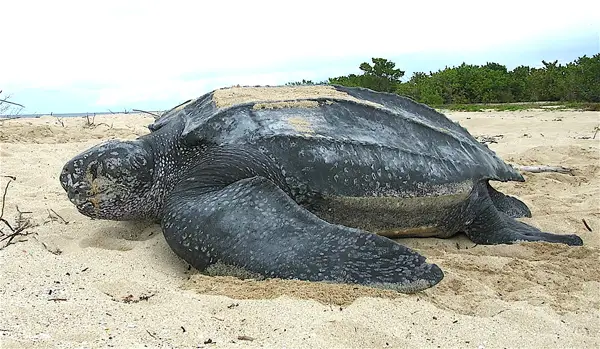
- Scientific name: Dermochelys coriacea
- Common name: leathery turtle, trunk turtle, Lute turtle, luth
- Family: Dermochelyidae
- Size: 5 to 6 feet
- Lifespan: 50+ years
- Conservation status: Vulnerable
The leatherback sea turtles are found in South Carolina state and are known to grow to mammoth sizes (up to 6 feet!). An average adult can also weigh as heavy as 540lbs!
Leatherback turtles usually have black shells. And they differ from other species of turtles with their smooth leathery carapace and skin. Their upper shell is made up of a flexible layer of dermal bones covered by tough and oily connective tissue and smooth skin.
The body of this turtle is barrel-shaped and then tapered to the rear. They have a total of 7 longitudinal dorsal ridges and their whole body is almost completely black, with some variable spotting.
Leatherback turtles in South Carolina have tooth-like cusps that work closely with their sharp-edged jaws to enable them to easily feed on jellyfish, salps, and other gelatinous zooplankton.
As for the habitat, these turtles of South Carolina are fond of tropical and subtropical waters all year round. But they tend to migrate to cooler, temperate, and boreal waters during warm weather.
Note that this species is highly migratory and can swim as many as 10,000 miles in a year between foraging and nesting grounds.
They’re also excellent divers—with the deepest diving record standing at whopping 4,000 feet!
18. Loggerhead Sea Turtle
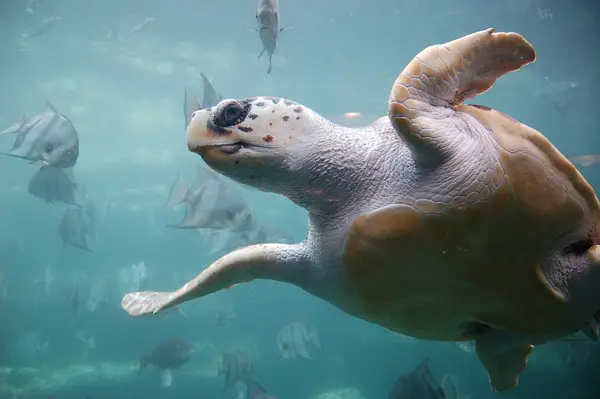
- Scientific name: Caretta caretta
- Common name: Loggerhead, Loggerhead Sea-Turtle
- Family: Cheloniidae
- Size: 3.5 feet
- Lifespan: 70+ years
- Conservation status: Endangered
Loggerhead sea turtles boast their place as the most abundant sea turtle species in the United States and are found in many states, including South Carolina.
These turtles are pretty big and can reach up to 3.5ft in length. They weigh up to 350 pounds and can live for a whopping 70 years or more.
A loggerhead is distinguished by a slightly heart-shaped carapace that’s reddish brown in color, with pale yellow plastron. Some species also feature yellow-bordered scutes.
This turtle species of South Carolina gets its name from its large head. It has powerful jaws that enable it to feed on a variety of foods including conch, whelks, insects, jellyfish, gastropods, and algae.
The loggerhead turtles of South Carolina are usually found in temperate, tropical, and subtropical waters all year round. However, they also tend to migrate to cold boreal waters on rare occasions.
19. Eastern Box Turtle
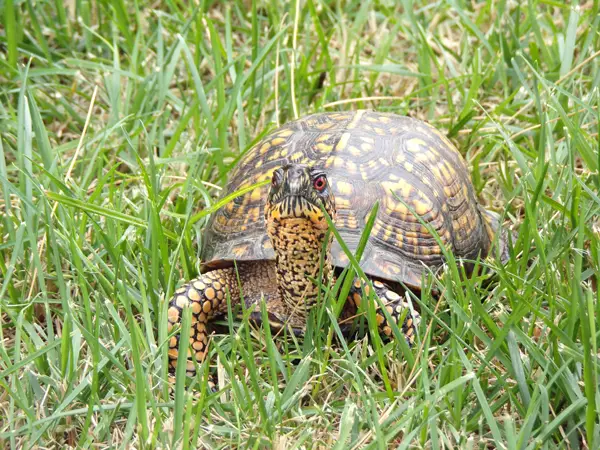
- Scientific name: Terrapene carolina
- Common name: Eastern Box Turtle, Land turtle, Box Turtle
- Family: Emydidae
- Size: 4.5 and 7 inches
- Lifespan: 50 to 100 years
- Conservation status: Vulnerable
The eastern box turtles of South Carolina are found in dense thickets and woodland areas. They prefer these areas due to abundant access to sunlight and food sources nearby.
An adult turtle of this species is about 4.5 to 7 inches and weighs just 2lbs. It has a high, domed shell shape with a ridge running from head to toe. The shell of this turtle has varying colors of olive, brown, and tan.
The variation in markings on the shells of these turtles is so variable that you can’t easily recognize one by looking at the shell alone.
These eastern box turtles of South Carolina are omnivorous and feed on a variety of foods including insects, meat, fruits, vegetables, and various types of vegetation.
Note that eastern box turtles are taken from the South Carolina wild for pet trade, leading to a decline in their population. For this reason, many states have illegalized capturing and selling of this species.
And those in captivity end up dying due to poor conditions or being abandoned or released back into the wild because they’re too demanding to maintain.
20. Gopher Tortoise
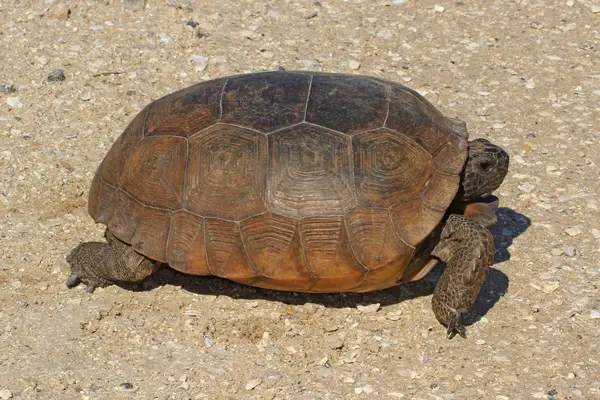
- Scientific name: Gopherus polyphemus
- Common name: Gopher
- Family: Testudinidae
- Size: 6 to 9.5 inches
- Lifespan: 40 to 60 years
- Conservation status: Vulnerable
Gopher is a fairly large tortoise and the ONLY tortoise inhabitant of the extreme southern areas of South Carolina land.
An adult has a size of 6 to 9.5 inches. They have brown or tan shell color and grayish-brown skin with yellow or orange botches.
The terrestrial reptile has its forefeet well adapted for burrowing. The front legs are scaly and shovel-like to allow for easy digging.
Mind you, this turtle gets its name from its ability to dig deep burrows—just like a gopher the rodent!
Even more interesting is that these burrows provide shelter to 360 other animals in South Carolina, including frogs, owls, engendered indigo snakes, etc.—making the tortoise a keystone species.
They mainly feed on vegetation such as mushrooms, grass, flowers, apples, and berries. Since they’re omnivorous in nature, they also feed on dead crabs or insects they come across.
Gopher tortoises tend to be more active during warmer weather. Their burrows can maintain more constant temperatures, making them safe havens for them.
NOTE that it is illegal to domesticate a gopher tortoise as a pet in South Carolina. They also face the threat of a declining population mainly caused by human interference.
South Carolina authorities limit land development in areas with these tortoises or their burrows. It is also illegal to relocate these species without permission from Fish and Wildlife Services.
Related: Turtles in Montana
Conclusion
Now you know the native and non-native turtle species living within South Carolina borders.
The list is made up of 20 species, the majority of which are native to the state and include the common snapping turtles, eastern painted turtles, diamondback terrapins, chicken turtles, bog turtles, yellow-bellied turtles, and others.
Gopher tortoise is the only tortoise species found in South Carolina’s extreme south areas and prefers living in grasslands where they dig burrows for shelter.
You’ll also find up to 5 endangered sea turtle species in this state. These include the green sea turtles, Kemp’s Ridley sea turtles, loggerhead sea turtles, leatherback sea turtles, and the Hawksbill sea turtles.
